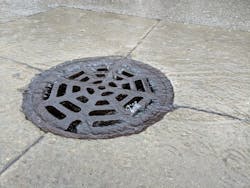America Needs to Fix its Sanitary Sewer System
On Friday, Nov. 5, Congress passed a massive $1 trillion bipartisan infrastructure package, which was subsequently signed into law, Monday, Nov. 15 by President Joe Biden.
With the passage of this measure, public works agencies across the country are ramping up plans to rehabilitate roads and bridges, modernize public transit, upgrade airports, ports, and waterways, and implement climate resilience and broadband initiatives. While these projects are critical, cities and public works agencies should also pay attention to another problem festering beneath the surface: sanitary sewer overflows (SSOs).
What are Sanitary Sewer Overflows (SSOs)?
SSOs are untreated raw sewage released into the environment that pose a great risk to human health. They occur when sewer lines clog or break, heavy rainfall overloads the sewer system, or due to equipment malfunction and power outages. SSOs create water quality issues, contaminate our environment, damage public and private properties, impact local and state economies, and negatively affect the quality of life in communities.
The U.S. EPA estimates that there are at least 23,000 to 75,000 SSOs per year in the U.S. Most SSOs are caused by aging infrastructure that needs maintenance or replacement. Given that much of the nation's sewage infrastructure is several decades old, the risks keep increasing every year. In recent years, several cities in Texas, including Houston, Corpus Christi, and Tyler have negotiated consent decrees with the EPA to upgrade their aging wastewater systems and reduce SSOs.
To address this issue proactively, cities and public agencies across the country should implement long-term sanitary sewer rehabilitation programs. The infrastructure bill allocates $55 billion to upgrade the country’s water infrastructure over a five-year period, with $280 million in municipal grants to address SSOs and stormwater reuse. While this amount is not enough to address all sanitary sewer issues, it is a down payment to get the ball rolling.
6 Long Term Sanitary Sewer Rehabilitation Needs
A long-term sanitary sewer rehabilitation program should include the following:
1. Flow Monitoring
The first step is to find out which part of the sanitary sewer system has the most issues and poses the greatest risk to the community. A flow monitoring program, which involves installing a network of flow meters and rain gauges at strategic locations, helps predict, record, and monitor where the flows are coming from. Flows entering the sanitary sewer system through defective pipe joints, pipe cracks, fissures, inappropriate connections, or through manholes can quickly overload the sewer and plant capacities. The flow data helps determine the extent of the problems and develop a rehabilitation plan to correct the issues.
2. Condition Assessment & Asset Management Program
In addition to flow monitoring, public works agencies should also develop a condition assessment and asset management program to determine the extent of sewer system defects and to prioritize where to focus the work. Using techniques such as CCTV and smoke testing, agencies can observe leaks, breaks, grease and fat buildup, blockages, faulty connections, and other structural issues. Using the information and observations, a weighted condition assessment and consequence of failure rating can be given for each system. These scores can then be used to develop a risk matrix to determine which assets pose the greatest risk and create a prioritized list of sanitary sewer components that require rehabilitation.
3. Preventative Maintenance
Another major cause of SSOs is lack of maintenance, which leads to further deterioration of an already aging sewer infrastructure. Inadequately maintained systems experience more clogged and collapsed lines due to root growth and accumulation of debris, sediment, oil, and grease. A sound preventative maintenance plan will reduce the frequency of SSOs and facilitate the timely repair or replacement of parts of the sewer system that may break and cause more serious and expensive problems.
4. Removal of Illegal Connections
An illegal connection permits extraneous water to enter the sanitary sewer system. These include connections of roof downspouts, sump pumps, footing/foundation drains, and basement drains to the house sanitary sewer lines, as well as deteriorated house sanitary sewer lines. By enforcing the removal of illegal connections, public works agencies can significantly reduce the excessive storm-related flows into the sanitary sewer system, freeing up system capacity and minimizing SSOs.
5. Public Education
Flushing inappropriate items down drains and toilets, especially flushable wipes (which are not really flushable) and Fats, Oils and Greases (FOG), cause pipe blockages, resulting in backups, spills, and overflows of raw sewage into customer homes and the environment. Unmaintained private sewer laterals that clog or fail due to tree roots or grease accumulation over time also contribute to SSOs. Helping customers understand what can and cannot be disposed of down toilets, sinks and drains, and educating them on the importance of maintaining their privately owned laterals will reduce the frequency and severity of SSOs.
6. Annual SSO Funding Allocation
Lastly, with respect to sanitary sewer systems, an ‘out of sight, out of mind’ attitude should not prevail. No system is foolproof from SSOs. Big rainfall events are going to happen every year and all sanitary sewer systems leak to a degree— some more than others. Cities, public works, and utility agencies should consistently engage the public on the importance of supporting utility rates at levels that fund maintenance operations and replacement/rehabilitation projects every year. By allocating annual funding for these projects, public works agencies will save taxpayer money in the long term.
Sanitary sewer systems are a critical part of the nation's infrastructure. Unfortunately, our sewer systems have been neglected for years in communities throughout the nation, sometimes even decades. Significant investments in repairing and rebuilding wastewater infrastructure are required to address the harms associated with SSOs. By implementing the above steps, public works agencies and utilities can reduce the risk of SSOs and improve the health and quality of life in their communities.


